Well ... float switches are simple and reliable. Having said that, it is not quite as simple as detecting a DC voltage. Using DC, the electrodes would quickly be corroded (damage due to electrolysis).
The sensing circuit needs to use AC. There used to be a nice IC made by National that would do this, the LM1830N; but as far as I know it is has been obsolete for some time. The circuit is pretty simple to do yourself. Basically an oscillator is connected to a series resistor and capacitor which is connected to an electrode in the fluid. That electrode also connects to a comparator to sense the AC. A second electrode connects to GND (circuit common). When a fluid is present, the conduction between the electrodes causes the AC signal on the oscillator electrode to be attenuated. The resistor sets the sensitivity.
Here is a circuit I built a few years ago using a PIC12F683 :

simulate this circuit – Schematic created using CircuitLab
This circuit was for a dual-level fluid sensor that would turn on a valve when the fluid would drop below the FLUID_LO sensor, and turn off when the fluid reached the FLUID_HI sensor.
I'm afraid I'm not free to publish the source code, but I will describe the functionality:
SENSOR_CLK is a 50% duty-cycle square-wave output. The frequency is not critical. I used appx 8Khz.
The AN0 and AN1 inputs to the PIC12F683 are inputs to the A/D converter. The conversions are performed when SENSOR_CLK is high. If the voltage is sensed below 3.1V, the corresponding electrode is considered to be immersed in the fluid.
FLUID_HI and FLUID_LO are wires positioned such that they are immersed in the fluid when at the appropriate level. FLUID_COM may either be connected to a metal container holding the fluid, or be connected to a wire in the fluid and below the level of FLUID_LO.
When the wires are immersed in the fluid, the square-wave detected by AN0 and AN1 is attenuated and has a net DC component of about 2.5V. Resistors R1 and R2 may be changed to smaller values if a less sensitive circuit is desired. The 3.1V detection threshold (in firmware) may also be changed to adjust sensitivity, but it must be greater than 2.5V.
While I used the A/D converter in the microcontroller, other detection methods may be used. Some microcontrollers have built-in voltage comparators that may be used. It may also be possible to use general-purpose I/O to detect the immersion when SENSOR_CLK is low if the Vin high and low thresholds are well below 2.5V.
I chose to sense the voltages between the resistors and capacitors instead of the voltages on the electrodes because I felt that the internal clamping diode to VSS in the microcontroller might cause a net DC voltage on the electrodes.
